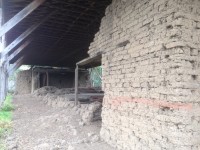Preservation must come from the heart and is a community-based grass roots effort. Tourists come to Sonoma each year for a variety of events knowing they will witness dozens of incredible old buildings. Many may be interested in the particular histories of each building, but I venture to say most are satisfied with the intangible feelings they get as their minds wander back in time. Antiquities should also be preserved because of the feelings people get in their gut when they see them walking down the country road or driving off into oblivion.
Just down the road on Broadway, I remember two ropes attached to an old tire hanging from a tree, swaying back and forth in the wind by an old farm house with barns. I could almost hear the children in the yard playing tag on a summer day, falling and scraping their knees which got bloodied by the rocky soil. I stopped to enjoy the setting one day, looking closely at the cut tin cans covering the knot holes on the bare wood barn. I came back a few weeks later to see nothing.
There are other aspects of Sonoma’s history that attest to our rural nature and can only be preserved via literature. This was a “cow town” from the get go. In fact, the phrase “when you’ve seen one cow you’ve seen them all” could be heard echoing from every saloon in the territory. Branding was an important aspect of our history.
Traditionally a brand may consist of a letter, number, symbol, or a variation of one or more of these. The purpose of branding and ear marking is to establish ownership and quickly identify one’s cattle in the open range. The technique dates back to the Egyptians over 4000 years ago. Europeans refined the techniques used to brand cattle, and individual brands became a proud mark of ownership. Speaking of Cortés, it was he who established a ranching tradition in Mexico by 1513, and his Holy Trinity brand, which consisted of three crosses, became the first brand recorded in North America.
Many of the Americans arriving in Sonoma in the mid-1840s began to purchase land, grow grapes and raise cattle. One such man was Nicholas Carriger. Carriger was a Tennessee native, who headed west in the spring of 1846 in the company of two other parties, including the Donner Party. The groups arrived together in Salt Lake City, and the Donner party decided to stay put for a while. Carriger warned that the weather could be too bad to cross the Sierra Nevada if they waited too long.
Carriger brought with him cattle, and in his diary writes about losing cattle to Indians along his journey. He writes, “While we were pursuing the cattle thieves, some Indians that had watched our movements stole three of our best horses; a loss which we felt most seriously and regretted very sincerely.”
Loss of cattle to thieves was a problem around Sonoma, and one of the first documented hangings occurred in 1854. Mules belonging to Mart Tarwater and Captain Hereford, who lived on Santa Rosa Creek, were taken by a rustler named Ritchie. Ritchie’s body was found hanging from an oak tree on Joe Hooker’s property in Agua Caliente.
In Sonoma, branding and ear marking became an important activity used to easily identify one’s livestock. Brands and ear markings had to be registered with the City of Sonoma. Most of the registered brands were hand drawn by early Sonoma settlers, and their artistic skills, while not better than my own, are up for debate.


Be First to Comment